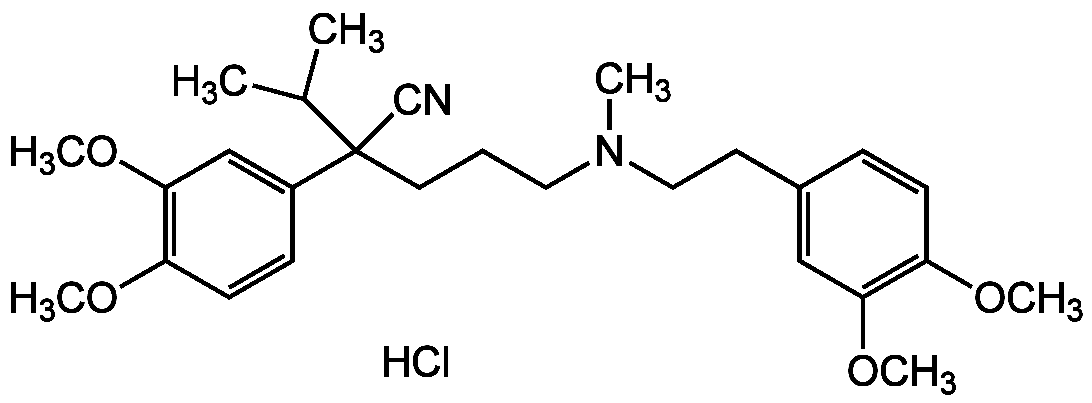(±)-Verapamil hydrochloride
| Code | Size | Price |
|---|
| CDX-V0007-M100 | 100 mg | £41.00 |
Quantity:
| CDX-V0007-G001 | 1 g | £72.00 |
Quantity:
| CDX-V0007-G005 | 5 g | £194.00 |
Quantity:
Prices exclude any Taxes / VAT
Overview
Regulatory Status: RUO
Shipping:
Ambient
Storage:
+4°C
Images
Documents
Further Information
Alternate Names/Synonyms:
Manidon
Appearance:
White powder.
CAS:
152-11-4
Class:
6.1
EClass:
32160000
Form (Short):
liquid
GHS Symbol:
GHS06
Handling Advice:
Keep cool and dry.Protect from light and moisture.
Hazards:
H301, H311, H331
InChi:
InChI=1S/C27H38N2O4.ClH/c1-20(2)27(19-28,22-10-12-24(31-5)26(18-22)33-7)14-8-15-29(3)16-13-21-9-11-23(30-4)25(17-21)32-6;/h9-12,17-18,20H,8,13-16H2,1-7H3;1H
InChiKey:
DOQPXTMNIUCOSY-UHFFFAOYSA-N
Long Description:
Chemical. CAS: 152-11-4. Formula: C27H38N2O4 . HCl. MW: 491.06. Synthetic Verapamil hydrochloride is an alpha-adrenergic receptor (alpha-AR) antagonist and calcium channel protein inhibitor that blocks the L-type Ca2+ channels in smooth and cardiac muscle cells. Verapamil is an antiarrhythmic agent and vasodilator known to reduce the renal clearance of digoxin and induce apoptosis in primary and metastatic colon adenocarcinoma human cell lines in vitro. It has been observed that verapamil can induce currents by itself, presumably by acting on the potassium and chloride leakage. Verapamil has also been used as an inhibitor of drug efflux pump proteins such as Mdr (P-glycoprotein). Verapamil is a substrate of CYP3A4 and CYP2C6. It is also used in fluorescent cell sorting for DNA content, as it blocks efflux of a variety of DNA-binding fluorophores such as Hoechst 33342. Recent research has shown verapamil to be an effective treatment for diabetes in animal models. Verapamil helps treat diabetes by limiting TXNIP expression.
MDL:
MFCD00055208
Molecular Formula:
C27H38N2O4 . HCl
Molecular Weight:
491.06
Package Type:
Vial
PG:
III
Precautions:
P261, P264, P270, P271, P280, P301, P310, P302, P352, P304, P340, P312, P322, P330, P361, P363, P403, P233, P405, P501
Product Description:
Verapamil hydrochloride is an alpha-adrenergic receptor (alpha-AR) antagonist and calcium channel protein inhibitor that blocks the L-type Ca2+ channels in smooth and cardiac muscle cells. Verapamil is an antiarrhythmic agent and vasodilator known to reduce the renal clearance of digoxin and induce apoptosis in primary and metastatic colon adenocarcinoma human cell lines in vitro. It has been observed that verapamil can induce currents by itself, presumably by acting on the potassium and chloride leakage. Verapamil has also been used as an inhibitor of drug efflux pump proteins such as Mdr (P-glycoprotein). Verapamil is a substrate of CYP3A4 and CYP2C6. It is also used in fluorescent cell sorting for DNA content, as it blocks efflux of a variety of DNA-binding fluorophores such as Hoechst 33342. Recent research has shown verapamil to be an effective treatment for diabetes in animal models. Verapamil helps treat diabetes by limiting TXNIP expression.
Purity:
>99% (Titration)
Signal word:
Danger
SMILES:
Cl.COC1=C(OC)C=C(CCN(C)CCCC(C#N)(C(C)C)C2=CC(OC)=C(OC)C=C2)C=C1
Solubility Chemicals:
Soluble in methanol (50 mg/ml), ethanol or water.
Source / Host:
Synthetic
Transportation:
Excepted Quantity
UN Nummer:
UN 2811
UNSPSC Category:
Fluorescent Reagents
UNSPSC Number:
41105331
Use & Stability:
Stable for at least 2 years after receipt when stored at +4°C.
References
(1) A. Fleckenstein; Annu. Rev. Pharmacol. Toxicol. 17, 149 (1977) | (2) I.B. Shchepotin, et al.; Anticancer Res. 14, 1027 (1994) | (3) B.B. Lonsberry, et al.; Pharmacol. 49, 23 (1994) | (4) W.T. Bellamy; Annu. Rev. Pharmacol. Toxicol. 36, 161 (1996) | (5) T. Kantola, et al.; Clin. Pharmacol. Ther. 64, 177 (1998) | (6) M. Verschraagen, et al.; Pharmacol. Res. 40, 301 (1999) | (7) G. Xu, et al.; Diabetes. 61, 848 (2012)
Related Products
| Product Name | Product Code | Supplier |
|---|



